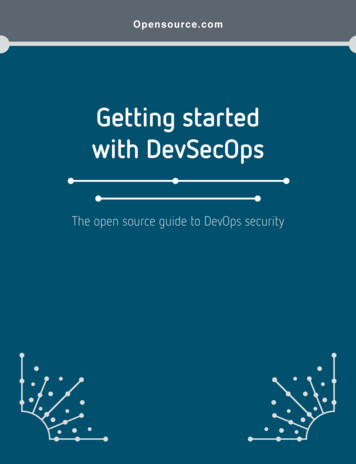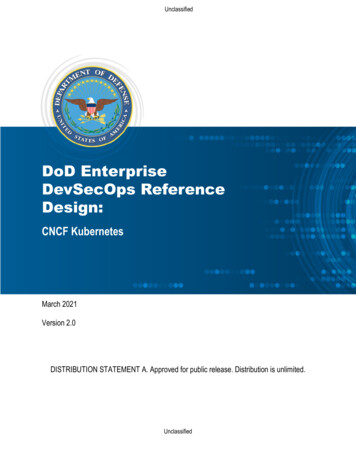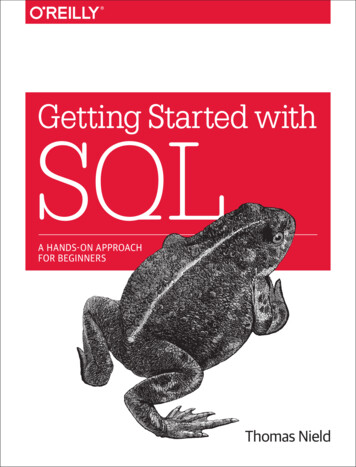
Transcription
Opensource.comGetting startedwith DevSecOpsThe open source guide to DevOps security
OPENSOURCE.COM . . . . . . . . . . . . . . . . . . . . . . . . . . . . . . . . . . . . . . . . . . . . . . . . . . . . . . . . . . . . . . . . . . . . . .ABOUT OPENSOURCE.COMWhat is Opensource.com?OPENSOURCE.COMpublishes stories about creating,adopting, and sharing open sourcesolutions. Visit Opensource.com to learn more about how the open sourceway is improving technologies, education, business, government, health, law,entertainment, humanitarian efforts, and more.Submit a story idea: https://opensource.com/storyEmail us: open@opensource.comChat with us in Freenode IRC: #opensource.com2GETTING STARTED WITH DEVSECOPS. CC BY-SA 4.0 . OPENSOURCE.COM
. . . . . . . . . . . . . . . . . . . . . . . . . . . . . . . . . . . . . . . . . . . . . . . . . . . . . . . . . . . . . . . . . . . . . . OPENSOURCE.COMINTRODUCTION4What is DevSecOps?CHAPTERS6Talking to normal people about securityWho will push back the most on a move to DevOps?3 security tips for software developers5 ways DevSecOps changes security81012GET INVOLVED ADDITIONAL RESOURCESGet involved Additional ResourcesWrite for Us Keep in TouchGETTING STARTED WITH DEVSECOPS. CC BY-SA 4.0 . OPENSOURCE.COM14153
INTRODUCTION . . . . . . . . . . . . . . . . . . . . . . . . . . . . . . . . . . . . . . . . . . . . . . . . . . . . . . . . . . . . . . . . . . . . . . . . . .What is DevSecOps?BY BRETT HUNOLDT AND AARON RINEHARTThe journey to DevSecOps begins with empowerment, enablement,and education. Here's how to get started.DEVSECOPSas a practice or an art form is anevolution on the concept of DevOps.To better understand DevSecOps, you should first have an understanding of what DevOps means.DevOps was born from merging the practices of development and operations, removing the silos, aligning the focus,and improving efficiency and performance of both the teamsand the product. A new synergy was formed, with DevOpsfocused on building productsand services that are easy tomaintain and that automatetypical operations functions.Security is a common siloin many organizations. Security’s core focus is protecting the organization, andsometimes this means creating barriers or policies thatslow down the execution ofnew services or products to ensure that everything is wellunderstood and done safely and that nothing introducesunnecessary risk to the organization.Because of the distinct nature of the security silo and the friction it can introduce, development and operations sometimes“DevSecOps enables organizationsto deliver inherently securesoftware at DevOps speed.”-Stefan Streichsbier4bypass or work around security to meet their objectives. Atsome firms, the silo creates an expectation that security isentirely the responsibility of the security team and it is up tothem to figure out what security defects or issues may beintroduced as a result of a product.DevSecOps looks at merging the security discipline withinDevOps. By enhancing or building security into the developer and/or operationalrole, or including a security role within the productengineering team, securitynaturally finds itself in theproduct by design.This allows companies torelease new products andupdates more quickly andwith full confidence that security is embedded into theproduct.Where does rugged software fit into DevSecOps?Building rugged software is more an aspect of the DevOpsculture than a distinct practice, and it complements and enhances a DevSecOps practice. Think of a rugged productas something that has been battle-hardened through experimentation or experience.It’s important to note that rugged software is not necessarily 100% secure (although it may have been at some point intime). However, it has been designed to handle most of whatis thrown at it.The key tenets of a rugged software practice are fostering competition, experimentation, controlled failure, andcooperation.GETTING STARTED WITH DEVSECOPS. CC BY-SA 4.0 . OPENSOURCE.COM
. . . . . . . . . . . . . . . . . . . . . . . . . . . . . . . . . . . . . . . . . . . . . . . . . . . . . . . . . . . . . . . . . . . . . . . . . . INTRODUCTIONHow do you get started in DevSecOps?Gettings started with DevSecOps involves shifting securityrequirements and execution to the earliest possible stage inthe development process. It ultimately creates a shift in culture where security becomes everyone’s responsibility, notonly the security team’s.You may have heard teams talking about a "shift left." Ifyou flatten the development pipeline into a horizontal line toinclude the key stages of the product evolution—from initiation to design, building, testing, and finally to operating—the goal of a security is to be involved as early as possible.This allows the risks to be better evaluated, socialized, andmitigated by design. The "shift-left" mentality is about moving this engagement far left in this pipeline.This journey begins with three key elements: empowerment enablement educationEmpowerment, in my view, is about releasing control andallowing teams to make independent decisions without fearof failure or repercussion (within reason). The only caveat inthis process is that information is critical to making informeddecisions (more on that below).To achieve empowerment, business and executive support (which can be created through internal sales, presentations, and establishing metrics to show the return on thisinvestment) is critical to break down the historic barriersand siloed teams. Integrating security into the development and operations teams and increasing both communication and transparency can help you begin the journeyto DevSecOps.This integration and mobilization allows teams to focuson a single outcome: Building a product for which theyshare responsibility and collaborate on development andsecurity in a reliable way. This will take you most of theway towards empowerment. It places the shared responsibility for the product with the teams building it and ensures that any part of the product can be taken apart andmaintain its security.Enablement involves placing the right tools and resources in the hands of the teams. It’s about creating a cultureof knowledge-sharing through forums, wikis, and informalgatherings.Creating a culture that focuses on automation and theconcept that repetitive tasks should be coded will likely reduce operational overhead and strengthen security.This scenario is about more than providing knowledge; itGETTING STARTED WITH DEVSECOPSis about making this knowledge highly accessible throughmultiple channels and mediums (which are enabled throughtools) so that it can be consumed and shared in whateverway teams or individuals prefer. One medium might workbest when team members are coding and another whenFinally, and perhaps mostimportantly, DevSecOps is abouttraining and awareness building.they are on the road. Make the tools accessible and simpleand let the team play with them.Different DevSecOp teams will have different preferences,so allow them to be independent whenever possible. This isa delicate balancing exercise because you do want economies of scale and the ability to share among products. Collaboration and involvement in the selection and renewal ofthese tools will help lower the barriers of adoption.Finally, and perhaps most importantly, DevSecOps isabout training and awareness building. Meetups, socialgatherings, or formal presentations within the organization are great ways for peers to teach and share theirlearnings. Sometimes these highlight shared challenges,concerns, or risks others may not have considered. Sharing and teaching are also effective ways to learn and tomentor teams.In my experience, each organization's culture is unique,so you can’t take a “one-size-fits-all” approach. Reach outto your teams and find out what tools they want to use.Test different forums and gatherings and see what worksbest for your culture. Seek feedback and ask the teamswhat is working, what they like, and why. Adapt and learn,be positive, and never stop trying, and you’ll almost always succeed.AuthorsBrett Hunoldt – Technologist, Security and Privacy Advocate,Parent, Gamer & Explorer.Aaron Rinehart – DevSecOps, Security Chaos Engineering ChaoSlingr, Entrepreneur, RuggedSoftware, InnovationCatalyst @UnitedHealthGrp.Adapted from “What is DevSecOps” on Opensource.com, published under aCreative Commons Attribution Share-Alike 4.0 International License at . CC BY-SA 4.0 . OPENSOURCE.COM5
TALKING TO NORMAL PEOPLE ABOUT SECURITY . . . . . . . . . . . . . . . . . . . . . . . . . . . . . . . . . . . . . . . . . . . .Talking to normal peopleabout securityBY MIKE BURSELLNormal people generally just want things to work.MOST PEOPLEdon’t realise quite how muchfun security is, or exactly howsexy security expertise makes you to other people.2 We knowthat it’s engrossing, engaging, and cool, they don’t. For thisreason, when security people go to the other people (let’sjust call them “normal people” for the purposes of this article), and tell them that they’re doing something wrong, andthat they can’t launch their product, or deploy their application, or that they must stop taking sales orders immediatelyand probably for the next couple of days until this is fixed,then those normal people don’t always react with the levelsof gratefulness that we feel is appropriate.Sometimes, in fact, they will exhibit negative responses—even quite personal negative responses—to thesesuggestions.The problem is this:security folks know howthings should be, and that’ssecure. They’ve taken thetraining, they’ve attendedthe sessions, they’ve readthe articles, they’ve skimmedthe heavy books,3 and allof these sources are quiteclear: everything must besecure. And secure generally means “closed”—particularly if the security folks weren’t sufficiently involved in thedesign, implementation, and operations processes. Normal people, on the other hand, generally just want thingsto work. There’s a fundamental disjoint between those two61points of view that we’re not going to get fixed until securityis the very top requirement for any project from its inceptionto its ending.4Now, normal people aren’t stupid.5 They know that thingscan’t always work perfectly; but they would like them to workas well as they can. This is the gap7 that we need to cross.I’ve talked about managed degradation as a concept [1]before, and this is part of the story. One of the things thatwe security people should be ready to do is explain thatthere are risks to be mitigated.For security people, those risks should be mitigated by“failing closed.” It’s easy to stop risk: you just stop systemoperation, and there’s no risk it can be misused. But formany people, there are other risks: an example being thatthe organisation may in factgo completely out of business because some 8security person turned theordering system off. If they’doffered me the choice to balance the risk of stopping taking orders against the risk oflosing some internal company data, would I have takenit? Well yes, I might have.But if I’m not offered theoption, and the risk isn’t explained, then I have no choice. These are the sorts of wordsthat I’d like to hear if I’m running a business.It’s not just this type of risk, though. Coming to a projectmeeting two weeks before launch and announcing that theGETTING STARTED WITH DEVSECOPS. CC BY-SA 4.0 . OPENSOURCE.COM
. . . . . . . . . . . . . . . . . . . . . . . . . . . . . . . . . . . . . . . . . . . . TALKING TO NORMAL PEOPLE ABOUT SECURITYproject can’t be deployed “because the calls against this APIaren’t being authenticated” is no good at all. To anybody.As a developer, though, I have a different vocabulary—anddifferent concerns—to those of the business owner. Howabout instead of saying, “you need to use authenticationon this API or you can’t proceed,” the security person asks,“what would happen if data that was provided on this APIwas incorrect, or provided by someone who wanted to disrupt system operation?” In my experience, most developersare interested—are invested—in the correct operation of thesystem they’re running and the data it processes. Askingquestions that show the possible impact of lack of security ismuch more likely to garner positive reactions than an initial“discussion” that basically amounts to a “no.”Don’t get me wrong; there are times when we, as securitypeople, need to be firm and stick to our guns.9 But in theend, it’s the owners—of systems, or organisations, or business units, or resources—who get to make the final decision.It’s our job to talk to them in words they can understand andensure that they are as well informed as we can possiblymake them. Without just saying “no.”Footnotes1. By which I mean “those poor unfortunate souls who don’tread these posts, unlike you, dear and intelligent reader.”2. My wife, sadly, seems to fall into this category.3. Which usually have a picture of a lock on the cover.4. And good luck with that.GETTING STARTED WITH DEVSECOPS5. While we’ve all met our fair share of stupid normal people,I’m betting you’ve met your fair share of stupid securitypeople, too, so it balances out.66. Probably more than balances out. Let’s leave it there.7. Chasm.8. Insert your favourite adjectival expletive here.9. Figuratively: I don’t condone bringing any weapons,including firearms, to your place of work.Links[1] tionactually-a-good-thing/[2] x-desktop[3] https://aliceevebob.com/AuthorI’ve been in and around Open Source since around 1997,and have been running (GNU) Linux as my main desktop athome and work since then: not always easy. [2] I’m a security bod and architect, and am currently employed as ChiefSecurity Architect for Red Hat. I have a blog – “Alice, Eve &Bob” [3] – where I write (sometimes rather parenthetically)about security. I live in the UK and like single malts.This article originally appeared on Alice, Eve, and Bob – a security blog and isrepublished with permission. [3]Adapted from “Talking to normal people about security” on Opensource.com,published under a Creative Commons Attribution Share-Alike 4.0 InternationalLicense at security. CC BY-SA 4.0 . OPENSOURCE.COM7
WHO WILL PUSH BACK THE MOST ON A MOVE TO DEVOPS? . . . . . . . . . . . . . . . . . . . . . . . . . . . . . . . . . .Who will push back the moston a move to DevOps?BY MIKE BURSELLDevOps will definitely bring change to your organization, and not everyonelikes change. Here’s how to manage those who fight the inevitable.YOU’RE MOVINGto a DevOps [1] model for all or part of yourorganisation: well done! Somebody, somewhere has madethe leap. Let’s assume, for the sake of this article, that youhave management buy-in: whatever hurdles needed to bejumped, whatever mountains needed to be climbed to getthat momentous “Yes.” You’ve got tooling agreed, you’veworked out your processes,and now all you need to dois convince people to getinvolved. Should be easy,right? If only.It turns out that not all people are as enlightened asyou, the reader of this article.Not everybody likes change,and if there’s one thingyou can be sure of, it’s thatDevOps will bring change toyour organisation—how youwork, what you do, how you interact with other people withinthe team and beyond.I’m going to describe five types of people or roles who maypush against a move to DevOps, along with a few thoughtsabout possible tactics to help move them along. We shouldremember, however, that you may not be able to move everybody along, and that there may be good reasons whypeople don’t want to change what they do, including the factthat what they do at the moment may work pretty well, bothfor them and for the organisation.Not invented here: Fear of the unknown“We’ve done it this way for the past [1/2/5/10/25] years, andit’s worked till now.” We’ve all heard this. It may be true,or it may not, but if your management has decided that amove to DevOps should be undertaken, even if the existing practices have been working, there’s probably been a8realisation that things could be more efficient, or faster, ormore secure.One of the defining points about this type of person or roleis that it often exhibits as a team concern. Teams becomeused to a particular way of doing things and settle into rolesand routines that work for them. What you’re suggesting isupsetting that team and making people do different things.You should consider how tomake the most of the teamas it exists now, maybe eventransitioning members ofthat team together or makinga point of celebrating theirsuccesses, rather than suggesting change is neededbecause they have in someway failed.My domain: Fear ofloss of controlAs a security person by background, this is one I’m veryaware of at a personal level. People who have gained a highlevel of expertise in a particular area or domain often feelthreatened when asked to change how they work or applytheir knowledge. They will often feel they are being askedto give up control and “water down” their expertise in a newworld where “everybody is the expert.”What’s important to stress in this context is that, ratherthan diluting their expertise, this is an opportunity to apply itacross a broader set of processes. Testing experts need toexplain to developers and operations folks, for instance, howtesting methodologies can be exposed in their realms. Typically, exposing experts to a wider audience will be seen bythem as a positive and, although there will always be “ivorytower” type personalities who struggle to interact in a moreteam setting, using them in ways where they take on a “consulting” type role may offer positive opportunities.GETTING STARTED WITH DEVSECOPS. CC BY-SA 4.0 . OPENSOURCE.COM
. . . . . . . . . . . . . . . . . . . . . . . . . . . . . . . . . . WHO WILL PUSH BACK THE MOST ON A MOVE TO DEVOPS?Stuck in my way: Fear of the newWhile very similar to “Not invented here,” this is more of anindividual than a group trait. Knowing what your tasks will beon a day-to-day basis may feel stultifying to some but can bevery comforting to many, which is why they may not want tomove to a world that seems much more “freeform” and unstructured. Not everybody can become the sort of generalistwho thrives on understanding all the different parts of theDevOps cycle.The good news is you will still need people who areready to settle down on specific tasks and complete themin particular ways. In fact, though there may be initial concerns about moving to a different way of working, explaining that team members will have a fair amount of controlover exactly how they perform particular tasks may be apositive message when trying to help this sort of individual. Hopefully, you will be including training—whether formalor informal—as part of your transformation to DevOps,and the chance to learn new skills (thereby increasing individuals’ mobility and career prospects) may also act asan incentive.People managers: Fear of losing powerIn many organisations, particularly those with a stronglydeveloped hierarchy, managers have a great deal of control over how their staff are deployed, what their tasks willbe, and how their career progression is managed. All ofthese can be directly at odds with a more open DevOpsapproach. For managers who have built their own littleempire, controlling their reports and subreports like pawnsaround a chess board, a move to DevOps will be challenging. For managers who are keen to grow membersof their teams into more expert employees, who measuretheir success on how many other teams ask for their reports to be seconded to their teams, and who enjoy seeingnew skills and career progressions taking place, DevOpsshould be an exciting opportunity.Part of any fix to the problem of resistant people managersis likely to be for executive management to offer both a carrot and a stick. The carrot can include changing how peoplemanagers are rewarded into a mechanism that embracesthese new behaviours, while the stick may involve removingteam members from those who are obstructive or changingthose managers’ role definitions.Unions: Fear of lack of certaintyIn certain industries and geographies, there are strongunions. A core mission of unions is to protect workers fromexploitation by management who may try to impose changeson workers that will not benefit them. Unions are by default(and understandably) suspicious of changes introduced bymanagement, so any move to DevOps that has been “blessed” by management may raise concerns and resistance fromunions and members of unions. In some cases, employeesGETTING STARTED WITH DEVSECOPSmay have very carefully described job roles that make it difficult to introduce ways of working where they are expected totake a more generalist role and learn new skills—both characteristics of DevOps.The good news is that DevOps can provide more controlto members of the team, in many different ways, somewhatreducing the control exercised by the management function.Explaining this and ensuring that appropriate checks are putin place to safeguard jobs will be key tasks in convincingunions and their members that this is a good change forthem. The other thing that should happen, of course, is thatmanagement should have included them early on in the process to make sure there has been buy-in from the beginning,rather than a decision “sprung” on them at the last moment.Some final thoughtsAs we progress to a bright new future, it is worth bearing inmind that a general good for all does not always translateinto a positive change for every individual. It is hard to arguethat the construction of sewerage systems is anything otherthan a general good, but it hits those whose only job has everbeen collecting the waste from the streets. Hopefully you don’tsee your move to DevOps as the construction of a new set ofsewers for your organisation, but be aware of those for whomchange can be difficult and disruptive. There can be a humancost to even the most well-intentioned development.For me, the most important point to remember is thatwhen people get defensive—and occasionally aggressive—it is generally because they feel threatened, and in allthese cases we’ve examined, change can be threatening.These people are your colleagues, they are people, too,and they should be treated with respect and considerationas people, not just as roles or obstacles to be overcome.In some cases, preserving the status quo in particular partsof your organisation may be the safest approach—for now,at least.Links[1] https://opensource.com/resources/devops[2] x-desktop[3] https://aliceevebob.com/ AuthorI’ve been in and around Open Source since around 1997,and have been running (GNU) Linux as my main desktop athome and work since then: not always easy. [2] I’m a security bod and architect, and am currently employed as ChiefSecurity Architect for Red Hat. I have a blog – “Alice, Eve& Bob” [3] – where I write (sometimes rather parenthetically)about security. I live in the UK and like single malts.Adapted from “Who will push back the most on a move to DevOps?” onOpensource.com, published under a Creative Commons Attribution ShareAlike 4.0 International License at k. CC BY-SA 4.0 . OPENSOURCE.COM9
3 SECURITY TIPS FOR SOFTWARE DEVELOPERS . . . . . . . . . . . . . . . . . . . . . . . . . . . . . . . . . . . . . . . . . . . . .3security tips forsoftware developersBY PETE SAVAGEDon’t make these common security mistakes that leave you vulnerable to attack.EVERY DEVELOPERknows the importance of followingbest security practices. But too often we cut corners, maybebecause we have to work hard until those security practices sink in. Unfortunately, that usually takes something likeseeing a security malpractice that’s so bad it gets marked inindelible ink in our brains.I’ve seen a lot of instances of poor security practicesduring my career as a sysadmin, but the three I’m going todescribe here are basic things that every software developershould avoid. It’s important to note that I’ve seen every singleone of these errors committed by large companies and experienced developers, so youcan’t chalk these mistakesup to novice junior engineers.1. Don’t encryptpasswords, hash them.Earlier in my career, Iworked for a company thatused a management system that held some prettyimportant information. Oneday I was asked to performa security review of the network and the software that stored our critical information.I spent a few minutes poking around before deciding tofire up Wireshark to see what traffic was running aroundthe network.I used my local workstation, logged into the informationsystem, and noticed something weird. Even though thiswas before SSL was all the rage, I did not expect to seedata in plain text containing bytes such as “username” and“password.” Upon closer inspection, it appeared that thesystem was sending my username and a random string—that was not my password—across the wire. I couldn’t let10it rest. I tried logging in again, except this time I purposelyentered my password wrong. I didn’t change all of it, just asingle character.What I expected to see was a completely different randomstring representing the password. Instead, only the first twobytes changed. This was interesting. Even though I was relatively inexperienced, I knew that if the representation of mypassword were hashed, as it should have been, it would beentirely different, not just two characters different. Heck, evena GOOD encryption scheme would do that. This, however,was not doing that at all. I tried two more wrong passwords.Armed with some sheets of paper and a pencil, I spentthe next two hours figuringout the decryption scheme.At the end of those twohours, I had a Python scriptthat could take any of those“encrypted” passwords anddecrypt it to reveal the original password, somethingthat no one should ever beable to do. I’m sure the person who dreamed up thisencryption scheme neverthought that someone witha couple of hours on their hands would ever sit down andwork it out, but I did.Why? Because I could.If you have to store passwords for comparison, never encrypt them, as there is always the possibility that someonecan find a decryption algorithm or key. A hash has no directreverse, meaning no one can reverse it unless they alreadyhave a table with the mapping from plain text to hash (or theysimply guess it). Knowing the hash mechanism doesn’t betray the integrity of the data, whereas knowing the encryptionscheme and keys will.GETTING STARTED WITH DEVSECOPS. CC BY-SA 4.0 . OPENSOURCE.COM
. . . . . . . . . . . . . . . . . . . . . . . . . . . . . . . . . . . . . . . . . . . . . 3 SECURITY TIPS FOR SOFTWARE DEVELOPERS2. Don’t put secret backdoors in software.As part of a third-party software rollout, I was supportingsome users who told me that their logins didn’t work. Thiswas a paid-for service provided by a vendor, but before troubling with what is usually one of the most annoying supportcalls (“My login doesn’t work”), I thought I would try it myself.It was true, the logins didn’t work.The system was a web-based learning managementplatform, of which we had paid for a small portion of itsgreater capabilities. As I poked around on the login pagea little more, something caught my eye. One character inone of the words looked different. Perhaps it was a differentfont, a slightly different shaped “o.” Me being me, I viewedthe page in source view, and noticed that there was a linkassociated with this particular letter. The link was purposefully hidden. The mouse cursor didn’t change on hoveringover it.I gingerly loaded that mystery link into a new browser window. All of a sudden, I was met with a screen detailing an entire suite of computers, giving me full control over what theycould do and the ability to shut them down, reboot them, takescreenshots, you name it. I telephoned the software vendorand asked to speak to the IT guy. After jumping through afew hoops, I finally got to someone who knew what I wastalking about.“Oh yeah!” he said. “We put that there for easy access, andno one ever found it until you. We’ll remove it right away.” Before we ended the call, he asked me one final question: “Whydid you start digging around in the HTML?”My answer was simple: “Because I could.”It’s just not worth the risk of putting some fancy backdooraccess into any system, because you can bet your bottomdollar someone will find it. No matter how obscure, codeanalysis—and just general prodding and poking—oftenyields the most surprising and interesting results.3. Authenticate users on every page—not onlyon the login page.At one point in my career, I was involved with a softwaredevelopment project that was being implemented by a seasoned developer. Feeling a little out of my league with thisGETTING STARTED WITH DEVSECOPSparticular application, I told my manager that we would needan in-depth security review of the code. I was asked to lookanyway to see what I could find. I started playing with theapp, logged in, and viewed some of the data. Then I foundsomething really interesting.If I bookmarked one of the URLs that I hit further into thesystem, I could just copy and paste it into another browser,and boom! I’d be there, without having to log in. I asked thedeveloper, “Why don’t you check the login on every page?If I just enter the URL of a page further into the system, Ican get there without logging in.” He asked, “Why wouldyou do that?”“Because I can,” I replied.Don’t leave anything up to cha
DevOps was born from merging the practices of develop-ment and operations, removing the silos, aligning the focus, . the heavy books,3 and all of these sources are quite clear: everything mus










